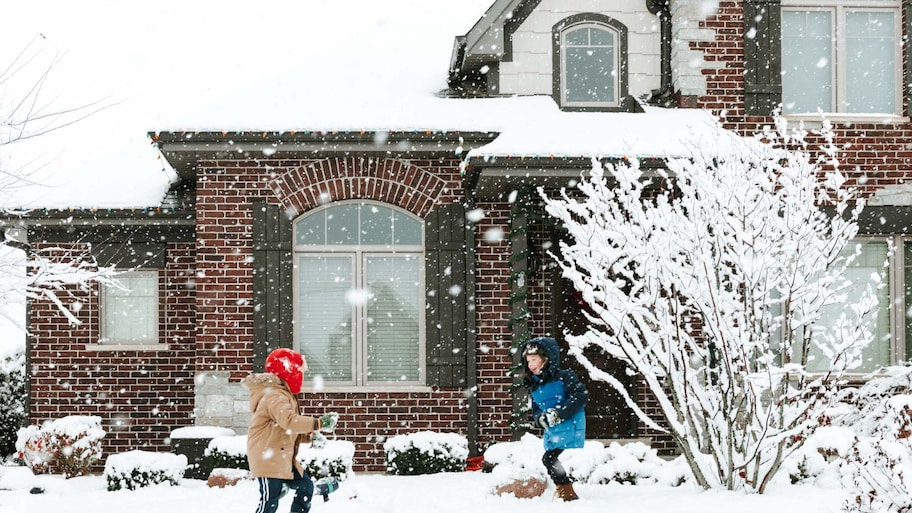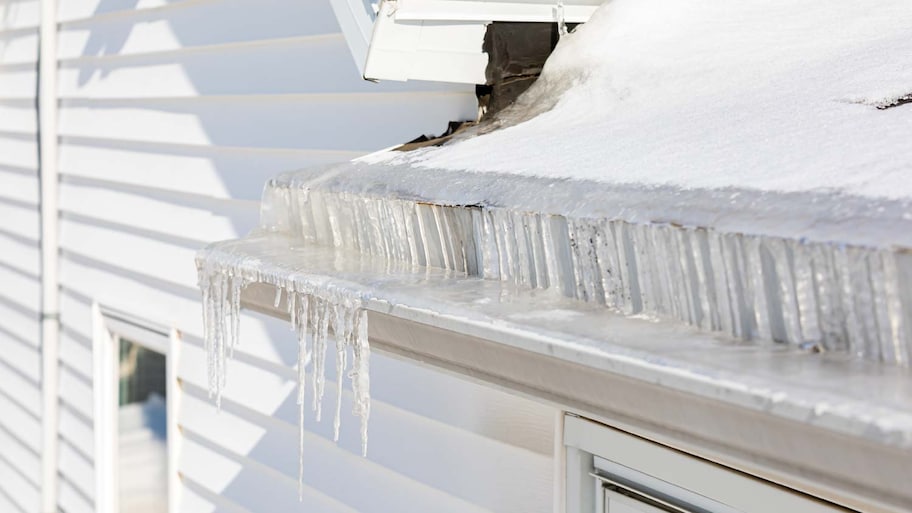Why Your Roof Is Leaking in the Winter: 10 Common Causes
Got a leaky winter roof? “Snow” problem! Here are some prevention tips


Highlights
Winter roof leaks are common and can compromise your home.
Ice dams, condensation, and roofing defects can cause leaks.
Aging roofing, clogged gutters, and flat roofs are other culprits.
Prevent roof leaks with annual inspections and maintenance.
Call a professional right away for roof leak repairs.
Winter is a magical time full of snowmen, holiday lights, and hot cocoa—but it is not the greatest season for your roof. Learn all about why winter roof leaks happen (hint: your roof may not even be the problem) and get roof winterizing tips so you can enjoy the colder months without worry.
What Causes Winter Roof Leaks?
It can certainly put a damper on your winter cheer if nasty weather is seeping down into your home. But if your roof only leaks during the winter, it may not actually be the culprit. Learn a few common reasons why your roof may only leak during the winter months and the issues a leaky roof can cause.
1. Ice Dams

If you have melting snow leaking into the house, you may have an ice dam. Ice dams form when snow collects on rooftops. As the snow melts and more snow falls on top, the water from the melt refreezes over the eave; this frozen roof water is often referred to as an ice dam.
As more melted snow moves to the eave, a dam forms and meltwater is pushed back under your shingles, eventually making its way into the attic, insulation, and eventually, the walls. Ice dam roof leaks can cause structural damage and compromise the integrity of your home’s sheetrock or wallboard.
2. Attic Condensation
If your attic is not well insulated, warm, moist air from your home can enter it—and if there is inadequate ventilation, it will stay there. Because attic temperatures are cooler than living space temperatures during the winter season, this moisture turns to condensation and collects on rafters and other wooden surfaces.
The droplets then fall and may seep through the ceiling, causing the appearance of a roof leak. The water can also put your ceiling rafters at risk for developing rot, mildew, and harmful mold. Rafter damage can make roofs sag over time, which will shift roofing beams and cause gaps in shingles and the roof structure, causing severe leaks.
3. Exhaust Fans
Exhaust fans, like the ones typically found in bathrooms, are not usually vented to the outside; they vent straight into the attic. As warm, moist air from the bathroom is exhausted into the attic through the ventilation system, condensation can form and turn to frost or ice, then melt and drip down in what appears to be a roof leak.
4. Compromised Flashing
Flashing is a vital component of a sturdy roof. It covers seams and gaps, like where the roof meets the chimney, to form a seal that prevents water from leaking through. If your flashing is damaged or cracked, melting snow or ice can leak through the imperfections, causing a leak.
5. Clogged Gutters

Surprisingly, clogged gutters are one of the main causes of some winter roof leaks. If all those autumn storms blew through and left your gutters full of leaves, sticks, and other debris, water from snow and ice melt has nowhere to go. As with ice dams, the water can push back under shingles and seep through into the attic and eventually down walls or through the ceiling.
6. Damaged Shingles
Shingles that are losing granules, cracked, missing, damaged, or compromised can cause roofs to leak in the winter and year-round. Asphalt shingles are easy to damage, and falling branches, hail, high winds, and aging can leave them weakened and susceptible to water intrusion.
7. Low-Slope Roof Style
There is a reason why steep, pitched roofs are common in snowy climates—they help snow and water to flow off the roof, preventing leaks caused by standing water. Flat or low-slope roofs, on the other hand, allow snow and meltwater to remain on the surface of the roof. This can encourage damaging ice dams and freezing and thawing cycles that compromise shingles and roof materials, as well as standing water that can flow down through attics all the way to foundations.
8. Structural Damage Caused by Water
It is important to prevent roof leaks and stop them as soon as they happen because unrepaired leaks and recurring water damage can lead to structural damage that may threaten your entire home. Tiny leaks flow across rafters and roof supports, down walls, and into the foundation of your home. Over time, leaks grow and the damage they cause multiplies, turning into dry rot, mold growth, supporting beam failure, and even foundation failure. For this reason, it is vital to have local roof leak repair companies near you come out and deal with even small leaks.
9. Shingles Are Nearing End of Life
We all want our roofs to last as long as possible, but stretching out your shingles’ lifespan too far can lead to leaks. Even if they do not appear damaged, shingles that have lost too many of their granules will not be as watertight. This can allow meltwater to get through, underneath, and around the shingles, causing roof leaks.
10. Exposed Nailheads
Just one misplaced nail can cause a flood inside your home. Roofs that are installed correctly will not have exposed or visible nailheads; instead, all nails will be secure and covered by shingles. Nailheads that are out in the open can shift, rust, or fall out, leaving a tiny hole in your roof where water can get in and cause big problems.
How to Prevent Roof Leaks in Cold Weather
For roof leaks, prevention is indeed the best medicine. Now that you know what causes roof leaks, here are some of the best ways you can catch them before they start:
Hire a licensed roofing contractor near you to perform an annual thorough roof inspection, even if you are not experiencing leaks. During inspections, the company should look for signs of aging or damage and areas of potential concern.
Replace damaged or aging roofing before leaks occur.
Keep your gutters clean and free of debris, especially before winter storms set in.
Only allow professionals to work on your roof; skip DIY skylight installation, DIY roof repairs, unlicensed roof installations, and work-by-day laborers or handyman services that do not have specific experience with roofing.
Take care of insulation and condensation issues before they become bigger problems.
What to Do if You Have Winter Roof Leaks
The key to winter roof leaks is prevention. Follow the tips above, including cleaning your gutters before temperatures drop and removing all the debris left over from storms and rain, so snowmelt has a way to escape the roof. You will also want to ensure your attic is well-insulated and ventilated to the outside to avoid condensation formation.
If you already have water seeping in through the ceiling or down the walls, call a professional local roofer for a roof inspection and damage diagnosis. They can check the integrity of your shingles and flashing and provide an estimate for repair. Most leaky roof repairs cost about $900 on average. The most important thing is to act fast—winter roof leaks can get worse very quickly, causing a lot of damage and ongoing issues.
Unfortunately, roof inspections and repairs in winter are tricky, especially in cold climates. Rooftop snow and ice make for a hazardous climbing environment, so this one is better left to the professionals, rather than a DIY project. Aim to get your roof checked out and repaired before the seasons change to prevent the problem altogether.
While repairing or replacing a roof in winter is not ideal, your roofer should at least be able to patch the problem so your home does not sustain more damage while you wait for spring. If your roof is severely leaking or you have had problems with hard-to-find leaks in the past, consider getting bids for roof replacement costs.
If the inspection process identifies ice dams, damaged shingles, or compromised flashing, professional emergency roofers in your area can repair the issue.
